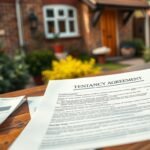Are you a landlord wondering what you must provide in an unfurnished rental property? The UK rental market is lively, and knowing your duties is key for success and following the law. You need to think about safety and essential amenities when getting your property ready for tenants.
Unfurnished rental properties are flexible for both landlords and tenants. As a landlord, you must ensure the property is safe and has basic amenities. This includes fitting smoke alarms on every floor and carbon monoxide detectors in rooms with gas appliances. You also need to make sure the property is secure with the right doors, windows, and fences.
There are also basic items you must provide. Tenants usually expect white goods like fridges, freezers, cookers, and washing machines. You should also have bathroom fixtures, kitchen fittings, and window coverings. While not legally required, these items can make your property more attractive to potential tenants.
Keeping the property in good condition and doing regular safety checks is crucial. You must do gas safety checks every year with a Gas Safe registered engineer. You also need to get electrical safety certificates. Remember to provide an Energy Performance Certificate and protect the tenant’s deposit in a government-approved scheme.
Key Takeaways
- Install smoke alarms on every floor and carbon monoxide detectors where necessary
- Ensure proper security measures for doors, windows, and fences
- Provide essential white goods and bathroom fixtures
- Conduct regular gas and electrical safety checks
- Supply an Energy Performance Certificate and protect the tenant’s deposit
- Consider offering additional amenities to increase property appeal
- Maintain open communication with tenants for a positive landlord-tenant relationship
Introduction
Unfurnished property rental is growing in the UK. It’s good for both landlords and tenants. Let’s look into unfurnished rentals and why landlords need to know their duties.
Overview of unfurnished rental properties and their benefits
Unfurnished rentals give tenants freedom to decorate. They also save landlords money on upkeep. About 45% of renters like unfurnished places for their decorating freedom.
- Lower maintenance costs for landlords
- Fewer damages to landlord-owned furniture
- Longer tenancy periods, reducing void times
- Cost-effective for tenants with existing furniture
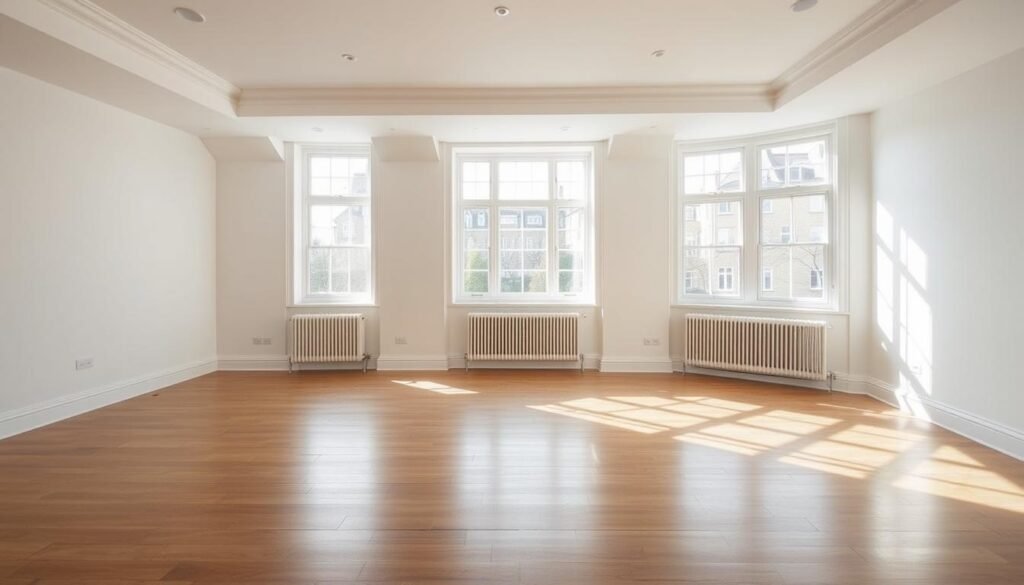
Importance of understanding landlord obligations for unfurnished rentals
Landlords must know their duties for legal reasons and to keep tenants safe. Unfurnished places might seem easier, but they still have rules. For example, 90% of tenants want basic appliances like fridges and ovens.
| Obligation | Importance |
|---|---|
| Safety equipment installation | Critical for tenant safety and legal compliance |
| Basic appliance provision | Enhances tenant satisfaction and rental appeal |
| Property maintenance | Ensures long-term property value and tenant retention |
Meeting these duties helps landlords keep tenants happy. This not only follows the law but also helps the rental market grow.
Basic Safety Requirements
Keeping rental properties safe and habitable is key for landlords. In the UK, there are strict safety rules to protect tenants.
Smoke Alarms and Carbon Monoxide Detectors
Landlords must fit smoke alarms on every floor. Carbon monoxide detectors are needed in rooms with coal or wood fires. These devices are crucial for keeping tenants safe.
House Security
Keeping properties secure is essential. Landlords must ensure doors and windows have working locks. Secure fences also add to safety. Regular checks make sure everything meets insurance standards.
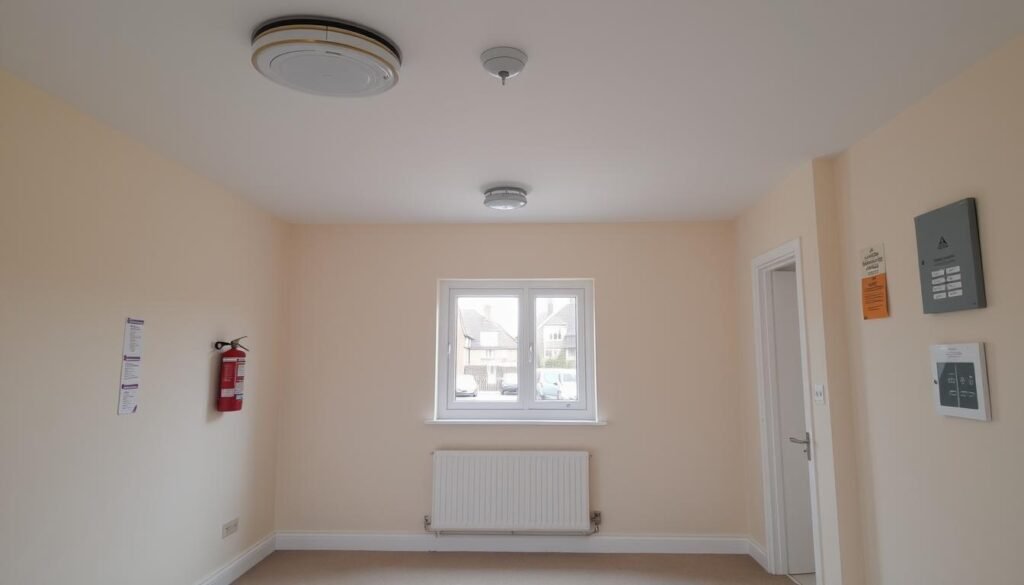
Gas and Electrical Safety Certificates
Gas safety checks are needed every year by a Gas Safe engineer. Electrical safety is just as important, with certified pros maintaining lights and appliances. Landlords must give tenants valid safety certificates.
| Safety Requirement | Frequency | Responsible Party |
|---|---|---|
| Gas Safety Check | Every 12 months | Gas Safe registered engineer |
| Smoke Alarm Check | Regular testing | Landlord/Tenant |
| Carbon Monoxide Detector Check | Regular testing | Landlord/Tenant |
| Electrical Safety Check | As needed | NICEIC-certified electrician |
Following these safety rules helps landlords create a safe home. It also ensures they follow UK rental laws.
Standard Legal Obligations
In the UK, landlords have many legal duties for rental properties. These rules protect tenant rights and make sure properties are safe.
Energy Performance Certificate (EPC)
An EPC is vital for rental homes. It shows how much energy a property uses and must be updated every 10 years. Landlords need a valid EPC before they can rent out a property.
Protecting Tenant’s Deposit
Keeping a tenant’s deposit safe is a big legal duty. You must put the deposit in a government-approved scheme within 30 days. This helps both sides and makes sure things are fair at the end of the tenancy.
Assured Shorthold Tenancy Contract
The most common rental agreement in the UK is the Assured Shorthold Tenancy (AST). It clearly states what both the landlord and tenant must do. This makes the rental agreement clear for everyone.
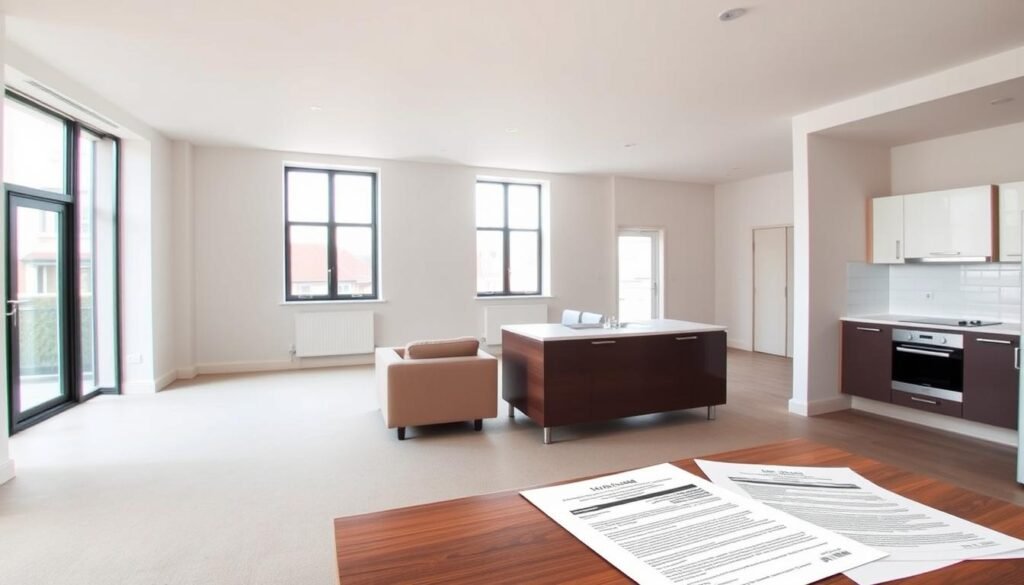
| Legal Requirement | Details |
|---|---|
| Energy Performance Certificate | Valid for 10 years, required before letting |
| Deposit Protection | Must be placed in approved scheme within 30 days |
| Tenancy Agreement | Assured Shorthold Tenancy (AST) most common |
| Safety Certificates | Gas and electrical safety certificates required |
Knowing these legal duties is key for landlords. It helps keep good relations with tenants and makes sure they follow UK laws for rental properties.
What should landlords provide in unfurnished rented properties?
Unfurnished rental properties often have more than just bare walls. Landlords usually give essential amenities. This makes sure tenants are comfortable and happy.
Light fittings
It’s important to have safe and working light fittings in every room. This includes ceiling lights and switches that work well.
White goods
Appliances like:
- Fridge-freezer
- Oven or cooker
- Washing machine
are key for daily life. Most tenants expect to find these in their homes.
Bathroom fixtures
Bathroom items that work well are vital. This includes:
- Toilet
- Sink
- Bath or shower
- Extractor fan (to stop damp and mould)
Window treatments
While not needed by law, many landlords add curtains or blinds. This helps with privacy and can make tenants happier and protect the property.
| Item | Typically Provided | Optional but Recommended |
|---|---|---|
| Carpets | Yes | – |
| Curtain poles/rails | Yes | – |
| Light fittings | Yes | – |
| White goods | Yes | – |
| Bathroom cabinet | No | Yes |
| Toilet roll holder | No | Yes |
By offering these basics, landlords can attract more tenants. This can lead to better relationships and less damage to the property.
Maintenance and Safety Provisions
Landlords have a big role in keeping properties safe and well-maintained. It’s not just about providing a place to live. You must also ensure the property meets legal standards for habitability.
Regular Gas Safety Checks
Gas safety is very important in rental homes. You need to get gas appliances and pipes checked every year. A Gas Safety Certificate from a certified engineer is required. Not doing this can lead to big fines or even jail time.
Electrical Safety and PAT Testing
Keeping electrical systems safe is also crucial. You must check the wiring regularly. It’s a good idea to test any electrical items you provide with PAT testing. This makes sure everything is safe to use.
Exterior Security and Pest Control
Keeping the outside of the property secure is key. Make sure all outside doors have working locks. Fix any pest problems quickly to keep the place safe. You must have smoke alarms on every floor, and test them every year.
| Safety Measure | Requirement | Frequency |
|---|---|---|
| Gas Safety Check | Mandatory | Annual |
| Electrical Safety Inspection | Mandatory | Every 5 years |
| Smoke Alarm Testing | Mandatory | Annual |
| Carbon Monoxide Alarm | Required in rooms with combustion appliances | Annual testing recommended |
By focusing on these safety steps, you meet legal rules and make a safe place for tenants. This attracts and keeps good tenants.
Furnished vs Unfurnished Properties
The rental market has many options to meet what tenants want. It’s important for landlords and tenants to know the difference between furnished and unfurnished rentals.
Defining Furnished and Unfurnished Properties
Unfurnished rentals have the basics like fixtures and white goods. Furnished properties add furniture and household items. Landlords might offer part-furnished options to attract more tenants.
Common Items in Furnished Properties
Furnished properties come with many items to make living easy. These include:
- Seating: sofas, armchairs
- Dining furniture: table and chairs
- Beds and mattresses
- Storage: wardrobes, chests of drawers
- Tableware: plates, cutlery, glasses
Custom wardrobes and quality fittings are a hit with tenants. But, landlords must follow Fire and Furnishings Act rules for soft furnishings.
| Property Type | Tenant Preference | Landlord Considerations |
|---|---|---|
| Furnished | Students, young professionals, short-term renters | Higher initial cost, more maintenance, potential for higher rent |
| Unfurnished | Families, long-term renters | Lower initial cost, less maintenance, potentially longer tenancies |
Furnished properties might get more rent but need better insurance and regular checks. Unfurnished rentals often mean longer stays and fewer disputes over deposits.
Tenant Expectations and Attracting Renters
In the competitive rental market, it’s key to know what tenants want. They look for more than just a place to live. They want a comfortable, safe space that feels like home.
Meeting Essential Expectations
To make tenants happy, landlords should offer important amenities:
- Quality kitchen appliances (oven, hob, fridge/freezer, washing machine)
- Well-maintained bathrooms with thermostatically controlled showers
- Effective ventilation systems
- Ample storage space, especially in unfurnished properties
- Energy-efficient features to reduce utility costs
Enhancing Property Appeal
To stand out, consider these upgrades:
- Offer outdoor spaces like gardens or balconies
- Install smart thermostats and energy-saving lighting
- Provide parking facilities, particularly in city centres
- Implement robust security measures (alarms, quality locks)
- Consider pet-friendly policies to tap into a growing market
Well-kept properties with good energy ratings attract renters. Meeting these needs will draw in quality tenants. This ensures your property’s success in the long run.
Building a Positive Landlord-Tenant Relationship
Creating strong bonds between landlords and tenants is key for successful rentals. A good relationship means better care of the property and longer stays. This benefits everyone involved.
Providing Basic Household Items as a Goodwill Gesture
Offering basic items can really improve tenant happiness. Think about giving doormats, bins, and cleaning stuff. These small acts show you value your tenants’ comfort and can keep them longer.
Fostering Open Communication and Mutual Respect
Good communication is vital for a positive landlord-tenant relationship. Quickly respond to tenant issues and be clear about what you expect. This can make tenants happier and more likely to recommend your property.
| Factor | Impact on Tenant Satisfaction |
|---|---|
| Quick maintenance response | High positive impact |
| Regular property upgrades | Increased renewal rates |
| Respecting tenant privacy | Builds trust and contentment |
| Timely communication | Enhances overall satisfaction |
By focusing on these points, you can make your rental properties a better place. This leads to happier tenants and an easier life for landlords.
Insurance Considerations
Landlord insurance is key when renting out properties. It protects your investment and gives you peace of mind. Many mortgage lenders require it.
Landlord Insurance and Contents Insurance Coverage
Landlord insurance covers buildings against damage. For unfurnished rentals, contents insurance might seem unnecessary. But, it’s good for covering items like carpets and white goods. Some policies also include public liability cover, protecting you if someone gets hurt on your property.
Reading Policy Details Carefully
It’s crucial to read your policy carefully. Look for:
- Excess amounts
- Restrictions on tenant types
- Coverage for loss of rent
- Legal expenses cover
Standard home insurance isn’t enough for rental properties. Landlord insurance costs more but is tailored to your needs. The price depends on your property and location. Knowing your policy well means your rental property is well-protected, giving you and your tenants peace of mind.
Conclusion
Knowing what landlords must do in the UK’s rental market is key to success. By giving the basics and following the law, you can make tenants happy. Most private rentals in the UK are unfurnished, which families like because they can bring their own things.
Offering both furnished and unfurnished options can help you find more renters. You need to provide basic appliances and make sure the place is safe. This includes working smoke alarms and heating and hot water that work.
Whether to rent furnished or unfurnished depends on who you want to rent to and where your property is. Furnished places near work can attract young professionals and get you more money. Unfurnished homes, on the other hand, are often preferred by families looking for a stable place to live. By meeting tenant needs and following the law, you can make a good profit in the UK’s competitive rental market.
